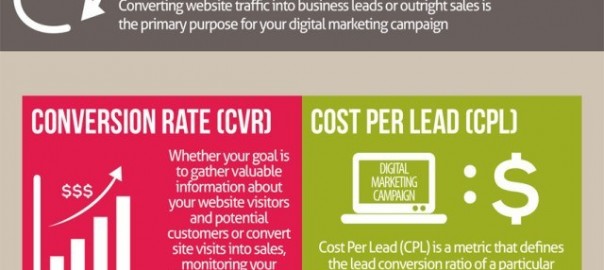
Last week, we began our discussion of 14 must-have metrics for digital marketing. We left off with those related to traffic generation. Today, we’ll talk about the rest of the must-have metrics for digital marketing.
Must-have metrics for digital marketing
Must-have metrics #6: Conversion rate
 Conversion metrics should be tied to each of your goals — both long-term goals and short-term ones.
Conversion metrics should be tied to each of your goals — both long-term goals and short-term ones.
I think it’s a big problem when you only metric for conversion is sales.
That’s because it’s a customer journey involving a number of intermediate steps before you get to a sale. So, you need metrics tied to each stage along the customer journey. You also need some notion of the attitudes driving those sales.
You also need some idea of what’s driving conversion — which channels and messages resonate best with your target market.
So, must-have metric #6 is actually a series of metrics necessary to determine not only how much traffic is converting, but what’s driving conversion.
The first step is building a conversion funnel in Google Analytics. Here’s a great video from Kissmetrics on creating conversion funnels.
As part of creating your conversion funnel, you likely already thought about what actions proceed conversion — email subscription, visiting a landing page, filling a shopping cart, checking out.
Create metrics that assess each of these actions. Along with visualizing the funnel, this helps identify where conversion is breaking down — do you need to drive more traffic, re-design your landing page, remove some clicks from the buying process, etc. A key point here is to remember that metrics are designed to guide decision-making — to improve performance. Metrics by themselves have little value. So, include metrics that help you know what actions will improve your market performance.
Next, you want to evaluation channels sending traffic that converts.
Does Facebook convert better? Or Twitter?
Do particular types of messages send more traffic to your site? Does message type impact conversion rate?
Again, do more of what’s working and stop what isn’t.
Finally, it’s important to determine attitudes associated with conversion. Having a text analytics platform that not only provides insights into satisfaction over time, but capable of providing more nuanced insights into consumers’ attitudes can really boost conversion rate.
For instance, if consumers think your products too expensive, you can ward off the effects of such negative attitudes by pointing out the value of your products — more durability, better performance, lower cost of ownership — over cheaper products.
Often, these metrics form KPIs (Key Performance Indicators) that guide metrics development.
Must-have metric #7: Cost per lead
Cost per lead starts us on the path toward revenue metrics by assigning a cost to each lead — commonly across different channels and funnels (Often there are different pathways leading to conversion Each funnel depicts a particular series of events). This offers firms insights into how to allocate resources across different channels and different funnel actions.
Cost per lead comes from dividing the number of leads generated via a particular channel (or funnel) by the cost to maintain that funnel, such as ad spend, cost for personnel and other resources to create posts in that channel, and amount of supervisor effort to edit and monitor that channel.
Must-have metric #8: Bounce rate
Bounce rate refers to the percentage of visitors who visit a single page of your website then exit. For some business models, bounce rate is important because it takes a series of page visits to consummate a sale. For others, a single page visit isn’t a major success factor.
Must-have metric #9: Average pages per visit
Average pages is another metric from Google Analytics, like bounce rate. While bounce rate only refers to the percentage of visitors who view a single page, average pages is more nuanced. Someone who views 20 pages per visit is likely qualitatively better — has a higher potential for conversion — than someone who viewed only 2 pages.
Must-have metric #10: Average time on site
Average time on site is just what it says — how long visitors spend on your site.
Of all the must-have metrics, this is the most deceiving because the visitor might be a slow reader, take a phone call with your website up, simply forget to close the tab (Google stops tracking after 1/2 hour of inactivity), or anything. I normally don’t pay much attention to this metric.
Bounce rate, average time on site, and average pages have meaning more as trends than as absolute point measures. If bounce rate, time on site and/ or average pages is not optimal, you might try things to improve these metrics. Over time, you should see improvement. If not, try something else to improve bounce rate and average pages. As I said, I pretty much ignore time on site.
Also, monitor bounce rate and average pages over time. Just because you optimized them at 1 point, doesn’t mean they’ll stay optimized.
All 3 metrics are important in the Google algorithm used to rank websites. Hence, they both impact how much traffic is generated to your site by impacting your position in SERPs (Search Engine Results Pages).
Must-have metric #11: Cost per pageview
Here’s another must-have metric designed to bring us on the path of revenue analysis.
Basically, you divide your expenses by the pageviews. Not one of my top 10, but interesting.
Must-have metric #12: Return visitors
This is really a great metric from Google Analytics because it shows how much folks value your content — they don’t come back often unless they like it.
Monitoring Google Analytics metrics
Most of what we talked about so far are must-have metrics from Google Analytics.
What’s missing are a whole bunch of valuable must-have metrics also available on this platform.
I love the customer analytics available from Google — especially now that they have built in cohort analysis, demographics and interests.
Customer analytics provide great insights into what motivates your visitors, what their lifestyles are like, and what they need. Mining this information guides content creation, product development, and help make your marketing more successful in lots of little ways.
Putting must-have analytics together
Google Analytics provides custom dashboards within the platform and these are a great way to bring all your must-have metrics into a single, downloadable place.
Must-have revenue metrics
Must-have metric #13: ROI
Some earlier must-have metrics should help calculate your ROI. For many businesses, this is the driving force and yardstick against which they measure success.
Not that I’m saying that’s right, I just understand.
Must-have metric #14: Customer acquisition cost
One thing to remember about customer acquisition is that not all customers are created equal.
That’s because order sizes vary across customers. So does the number of orders.
Revenue or yield management is a process whereby you optimize revenue by evaluating the importance of different customers (often CLV or customer lifetime value). For instance, airlines charge business travelers more because they travel more often and represent a higher lifetime value to the airline. Plus, they’re not as price sensitive as passengers traveling for pleasure.
In exchange for higher prices, business travelers gain points for upgrades and other perks to make their travel more enjoyable.
In addition to customer acquisition costs, it’s really important to assess the value of individual customers (or groups) to the organization and develop plans to retain those most valuable and reduce costs to those who represent less value.
You’ll also want to track behaviors of customers who represent more or less value to the organization. Do they share similar channels? For instance, do Facebook customers spend relatively little compared to customers acquired through other channels?
(219)
Report Post






